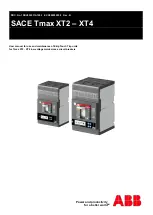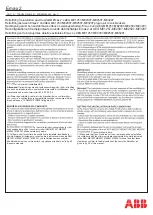
Effective 10/2004
Page 14
I.L. 70C1036H05
trip unit is energized and operating properly
(See Figure
3.1).
In an overload (Long Pickup) condition this status LED
flashes at approximately 4 times per second while the
overload persists.
3.2.2 Alarm LED
In addition to the green status LED, a yellow alarm LED is
provided to indicate real time alarm conditions existing on
the power system. See Appendix D-16 for the programing
of these alarms. Also, if an unusual condition is detected
within the Digitrip’s hardwire or firmware, this LED will light
along with an ALARM message.
3.2.3 Trip LED
The trip LED is illuminated upon any trip condition. It is
also a real time display and incorporates the circuit
breaker’s 52b auxiliary switch (also called MCR switch)
input for its logic. Pushing the Reset pushbutton or closing
the circuit breaker will clear this LED.
3.3 Making Current Release
All Digitrip 1150 Trip Units have a Making Current Release
function. This safety feature prevents the circuit breaker
from being closed and latched-in on a faulted circuit. This
is a nonadjustable sensing circuit. It is preset to trip at an
instantaneous current numerically equivalent to 25 x (
I
n).
(Note that currents of ~11 x (
I
n) with maximum asymmetry
also reach this threshold.)
The Making Current Release is enabled only for the first
two cycles following an initial circuit breaker closing
operation. The Making Current Release will trip the circuit
breaker instantaneously and flash the Instantaneous LED
as well as indicating “Making Current Trip” on the display
panel.
3.4 Zone Interlocking
CAUTION
IF ZONE INTERLOCKING IS NOT TO BE USED AND
ONLY STANDARD TIME-DELAY COORDINATION IS
INTENDED, JUMPER TERMINAL B8 TO B9 ON THE
CIRCUIT BREAKER SECONDARY CONNECTOR.
Zone Selective Interlocking (or Zone Interlocking) is
available on the Digitrip 1150 for the Short Delay and
Ground Fault protection functions
(See Figure 3.1).
The
zone interlocking signal is wired via a single set of
wireslabeled Zone In (Zin) and Zone Out (Zout) along with a
Zone Common wire. The Zone Selective Interlocking
function combines the interlocking of Short Delay and
Ground Fault. A zone out signal is issued if the ground
fault pick-up is exceeded or if the short delay pickup is
exceeded or if the value of 2 x (
I
r) is exceeded. Zone
Selective Interlocking provides the fastest possible tripping
for faults within the zone of protection of the circuit breaker
and yet also provides positive coordination among all
circuit breakers in the system (mains, ties, feeders, and
downstream circuit breakers) to limit a power outage to
only the affected parts of the system. When Zone Inter-
locking is employed, a fault within the zone of protection of
the circuit breaker will cause the Digitrip 1150 to:
•
Trip the affected circuit breaker immediately and, at the
same time,
•
Issue a signal to upstream Digitrip units to restrain from
tripping immediately. The restraining signal causes the
upstream circuit breakers to follow their set coordination
times, so that the service is only locally disrupted while
the fault is cleared in the shortest time possible.
For an example of how Zone Selective Interlocking may be
used, see Appendix A of this Instructional Leaflet.
3.5 PT Module
The PT (Potential Transformer) Module
(See Fig. 3.0 and
Appendix C)
is internally wired in the circuit breaker to the
line side circuit breaker terminals. It provides signal data to
calculate voltage, power, energy and related data. The PT
module is a three phase, three wire input and three wire
output step down transformer with a
wye to wye
hookup.
The power (and energy) metering and protection is calcu-
lated with the convention that power flow is from top to
bottom through the circuit breaker. This assumes the top
side conductor to be the
line
side. If the distribution
system is such that the bottom side is the
hot
side, the
power values will indicate
Reverse Power
. This reading can
be made an absolute value by installing a jumper from B-3
to B-7 of the secondary contacts.
CAUTION
A DIELECTRIC DISCONNECT PLUG LOCATED ON THE
LEFT SIDE OF THE CIRCUIT BREAKER IS PROVIDED
WITH THIS MODULE AND IS TO BE REMOVED WHEN
DIELECTRIC TESTING OF THE CIRCUIT BREAKER IS
CONDUCTED. FAILURE TO REMOVE PLUG WHEN
TESTING CAN RESULT IN DAMAGE TO TRIP UNIT AND
PT MODULE.










































